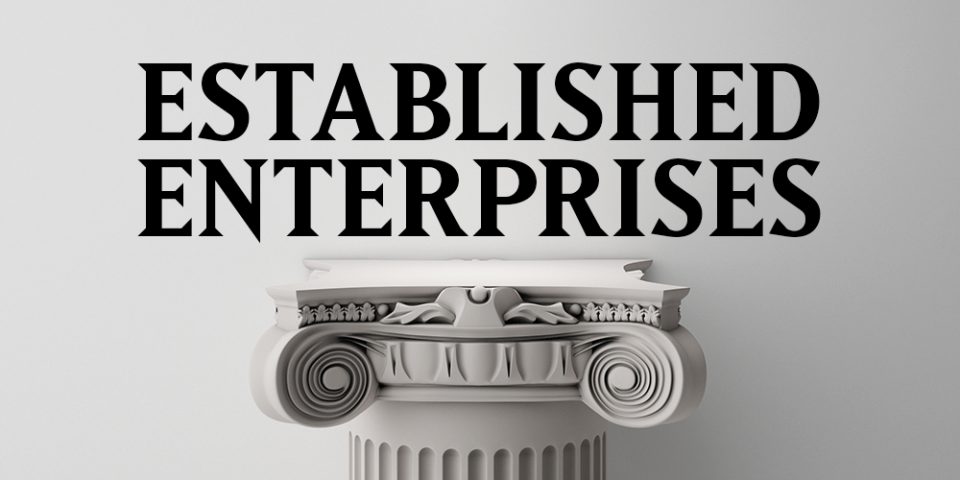When we look at established systems with hundreds of locations, it’s natural to wonder about their recipe for success. Is it the products and services? The consistent operations? The brand recognition?
Grant Bullington, franchise consultant at FranNet, says an established organization can offer great benefits to franchisees. “First, there isn’t nearly as much guesswork or wondering about the potential future success when we compare it to a newer or emerging franchisor. The more senior system has had many years to work out the kinks in their systems, and to focus on continued incremental gains. Also, a new franchisee can immediately benefit from the strong brand power and recognition of a more established concept – you get to harness it instead of having to build it.”
We spoke to three established franchise concepts to find out how they age gracefully and continue to create a big impact.
Boston Pizza
With 397 locations across Canada, Boston Pizza offers more than 80 menu options for kids and adults alike. “We have two unique experiences under one roof. It’s a family-friendly restaurant on one side, and a lively sports bar on the other. We’ve been able to uniquely position ourselves by complementing the different demographics,” says Felix DeCata, vice president of national development.
A big part of the company’s success is the powerhouse behind the brand, Jim Treliving. Once a franchisee himself, Treliving continues to cling to his roots, honouring the challenges of franchising by building offices and establishing best practices up front to ensure franchisees have the support they need daily.
With plenty of opportunities to grow across Canada, the right locations and the right franchise partners are paramount. “We are a very patient company, and we’ll wait for the right location and franchisee before we grow,” says DeCata. In turn, as an established system, Boston Pizza is able to leverage its resources to offer the best in buying power, from food costs to marketing initiatives. In fact, it remains one of the few systems that doesn’t charge royalties on alcohol sales.
As a larger operation, DeCata says it’s important to stay in touch with the franchise network. They maintain contact through advisory committees, regional meetings, and more. “I think transparency and having an open line of communication both ways is very important.”
As an established brand, the corporate office assists with anything from training and support to operations and marketing. “We try to help by having franchisees focus on the execution while we do the legwork,” says DeCata. With so many moving parts, he adds that a committed franchisee will set themselves up for success.
His advice? Don’t rush into anything and do your due diligence. “Find out who your competitors are, speak to existing franchisees, visit locations, and make sure you really understand who the franchisor is.”
Great Clips
Great Clips continues to snip its way across the United States and Canada, and credits this success to franchising. “Early on, we decided that franchising was our growth vehicle,” says Steve Hockett, chief executive officer. “Franchisees operating in the communities they live in is part of what differentiates us. It takes a lot of discipline to establish multiple franchisees in every market. It’s how we grow, and will continue to grow. We grow at a measured pace.”
The first salon opened in Minneapolis in 1982, and 37 years later, the menu price board still looks the same. “The strength of Great Clips is that we know who we are. We know what we’re good at – and our singular focus on haircuts is a powerful part of the brand,” says Hockett.
New technology allowed the brand to reinforce its commitment to convenience, ease of use, and the ability to get a haircut anytime. The online app allows customers to check wait times, and the innovative Clip Notes feature stores haircut details, so customers can get the same experience at any Great Clips in Canada and the United States
Today, they boast over 4,400 units, and 1,200 franchisees who employ 40,000 stylists, and this is a big draw to prospective franchisees. “We are the official hair salon of the National Hockey League. If you go with a smaller concept, you won’t have that. It takes dollars and a brand and distribution to do that. When you start out, you can’t have the technology we have today. It takes resources.”
In addition to a track record of business success and a people-centric attitude, Hockett says it’s essential that franchisees embrace the system. “Live within the system, and don’t try to change it right away. Over time, great systems evolve because their franchisees help them evolve.”
Mary Brown’s Chicken & Taters
One of the largest Canadian quick serve chicken restaurants, Mary Brown’s celebrated its 50th anniversary this year. In the wake of the milestone, the brand has taken on a whole new look, with a fresh new logo and modern, streamlined interiors.
With 160 locations serving Made Fresh from Scratch™ chicken cut and breaded by hand, and taters handcrafted from farm fresh Canadian potatoes, the brand plans to expand to 200 locations by 2020.
What makes Mary Brown’s unique? Well for one thing, taste. Husband and wife team Waqar Azam and Aysha Waqar knew they wanted to own a business. “We knew we wanted a restaurant, and we wanted a franchise,” says Waqar.|
“We said, first things first, we both need to love the product. Only then can we sell it with pride,” says Waqar. The couple now owns four locations, but the first they purchased was an existing restaurant. “As an accountant, I was putting my investment in safe mode. We took baby steps, one step at a time. Liking the product is one thing, but having the experience and seeing how the profitably was, both things have to work. My passion is to serve, but my pocket has to be served, too.”
During the first year, as Waqar struggled to get familiar with the business concepts, Aysha stepped in to help. “I am a good accountant and she is a good administrator. When she jumped in, we were starting to get a good picture of our investment, and the opportunity to buy another store popped up.”
With established systems and support in place, the couple was able to open four stores in four years. “The franchise support is amazing, we have no words for that,” says Aysha. “The first year was quite crucial for us because the food business was new, but it was due to their support that every year, we were able to make the jump to another store.”
“When I looked at our main competitors and the growth they were experiencing, there was no comparison. What brought us here was sheer taste, consistent taste at every location.” Waqar adds that there was an immediate connection with the corporate team from the start, a personal touch that brought them into the fold from day one.
Waqar’s advice? “Jump in, just go for it. When you have your own business, you need to feel confident in yourself, your product, and the support. Today is the time to jump in.”
Expert advice
When investing in an established model, Bullington says there are fewer unknown variables when it comes to investment costs. “A system that opens several new units a week will have a more detailed and consistent investment breakdown when compared to the system that only sees several new units a quarter.”
On the flipside, big systems aren’t for everyone. Franchisees in larger systems may feel less significant, and their attempts to provide input unheard. “If you’re one of hundreds of franchisees, you simply aren’t afforded that much of a voice. Generally speaking, well-established and comprehensive systems tend to lack room for your flexibility, innovation, and creativity. This can be a legitimate cause of concern for some owners.”
For those new to franchising, he suggests benchmarking preferences by talking through a familiar situation: “If you were to go and get another job, would you prefer to work for an IBM-sized company, a startup, or a smaller family business? Your response might yield some telling insight as to the size and scale of your ideal franchisor.”
“Above all, clearly understand what you are looking for and where you will best fit in a franchise system. It can be comforting knowing that you’re joining potentially hundreds of other franchisees in your decision. Be careful to not get swept up with mob-mentality thinking and make sure that it’s the right business for you.”
Established Brand or Startup: Which Franchise is Best for You?
While buying a franchise from an established “big brand” doesn’t guarantee instant success, there are definitely advantages that can provide a measure of security that is often missing with “startup” companies. An established franchise has instant brand recognition; the net effect of reducing a potential customer’s purchase time by giving them a pre-qualified choice. In other words, a customer will purchase a Big Mac without much thought because they know what it tastes like. There are no surprises. No risk. The McDonald’s brand has communicated a defined level of quality and service that customers expect and receive every time they order a Big Mac.
Established brands also have proven systems and procedures including training, bulk buying advantages, marketing support, and tried and tested systems for operations, accounting, etc. When you purchase from an established brand, you are in a sense buying an accelerated learning curve. Your franchisor has probably already encountered and overcome the problems/challenges you will face as a new franchisee, so you can benefit from their trial and error. This increases your chance to hit the ground running so to speak and to start to build business equity faster.
But all that glitters is not gold.
There are many established brands that although they may have been around a long time, and their names are recognizable, have become stagnant and tired. It is important to look at the brand carefully. How many locations have they opened recently? How many have they closed? Is the product or service they sell relevant in today’s day and age? Think of all the big brands that at one time were “hot” and then they were not. Jumbo Video was a well-known brand for many years but when the digital age took over, they became obsolete and the franchise disappeared.
Look at the brand for what it is now and how it will sustain itself in the future. Is the brand constantly evolving to keep up with the demands of today’s consumer or is it stuck in the past? Has the brand oversaturated the market, making it difficult for new franchisees to establish a trade area of their own? Has the brand kept up with today’s technology? Do they have enough operational support for all their franchisees or are they spread too thin? Have they grown too quickly to sustain themselves and their franchisees? Sometimes slow and steady is the best option when it comes to the franchise race.
Whether you choose a big brand or an up-and-coming brand, you must do your due diligence. It requires a significant effort and commitment, but it is well worth it. Do your homework. Ask questions and take your time. Making the right franchise choice is the right business decision.
By Gina Makkar


